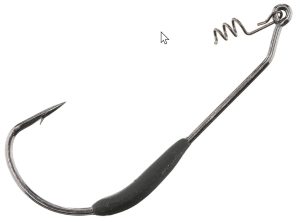
Herring are a prolific baitfish in a lot of our eastern lakes. From Virginia north, they’re mostly alewives, and from Virginia south it’s generally bluebacks. Despite some differences, they’re very similar – long, skinny, and they just about always travel in schools. When they’re spawning, bass gorge on them because they’re an easy meal.
While a lot of other baitfish dart left to right or make a wide glide, bluebacks tend to move in a straight line. They’re also not necessarily blue – they have white or pearl sides and a greenish or brown back. Don’t believe me? Google them.

Those characteristics mean that you can use a lot of different lures to imitate them, but I have certain favorites. Number one shouldn’t surprise anyone – it’s a fluke! Just look at that profile, it’s the exact same as a herring. They come in multiple sizes but a 5-inch Berkley Power Jerk Shad is my money model. It may be a simple bait, but there are at least three good ways to rig them. First is weightless and Texas Rigged. I love this because I can fish it through and around just about anything, from bank grass to dock floats and it’ll be weedless. Instead of the normal 2/0 or 3/0 hook, I use a heavy gauge EWG 4/0 or 5/0. That helps keep the bait down and provides a big gap for when they strike.

My second favorite way is with a weighted swimbait hook like the VMC Drop Dead model, again in 4/0 or 5/0. You screw it into the nose and then you can Texas rig or Texpose it, depending on the cover.

Finally, if the cover allows, the best way is with an exposed hook. The bluebacks often spawn on flat red clay points, gravel points or sandbars with no cover. If you’re not worried about getting snagged, you want maximum exposure. I like a straight shank hook for this like the VMC Finesse Neko in 3/0 or 4/0. You just old school thread it on so it sticks out the back, nice and straight. If they’re still short-striking, you can even add a little feather treble stinger.
Remember, you want the movement to be straight, so no matter how you rig the fluke you want to pull the bait a lot. Don’t twitch it like you would when imitating shad.

Historically, a spinnerbait might have been my second choice, but in recent years I’ve realized that a swimbait is even better. In particular, a Berkley Hollow Belly is the deal. While some other styles have a wide-swinging tail that pushes them left to right, the hollow belly has just a little bit of left to right movement. It’s mostly body roll, and every time it rolls there’s a little bit of flash.

I right the swimbait on a jig head like a VMC Boxer or a VMC Swimbait Head when there’s not a lot of cover around. You have to make sure not to overpower it—1/4- to 3/8-ounce is usually enough. Just cast it out and don’t do anything crazy. Reel it back at a moderate to moderate-fast pace. If the cover is heavier, I prefer a weighted swimbait hook.

Last but not least, my cleanup lure is a walking style topwater like a Rapala Skitter V. Again, look at that profile, it’s exactly like the baitfish the bass are chasing. Don’t worry about your chartreuses, oranges and greens. I want chromes, whites and pearls. When it’s low light conditions or cloudy, I like the solid patterns, and as the sun gets up, particularly if it’s clear and calm, I usually do better on the translucent ones. Remember, these herring move STRAIGHT so you don’t want to walk the dog. Instead, pull it like you pulled the fluke so it’s waterskiing across the surface with just a little bit of head movement.
Chasing herring biters is one of the most exciting and potentially rewarding way to catch big bass and lots of them. Try these three lures and you should be covered for a wide range of situations.
_________________________________________________

_______________________________________________________
Like Ike on Facebook, and follow him on Instagram and TikTok for fishing and fun content.
Subscribe to Mike’s YouTube channel, to ensure you see every adventure video. (Download the YouTube app on your phone and the videos will come to you automatically.)